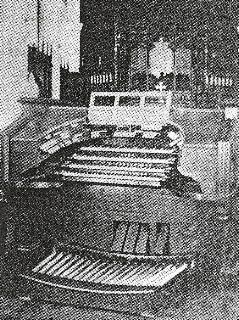|
Builder: Hope-Jones Organ Co, Opus 10 (1910) Manuals: 4 Ranks: 8 Action: Electro-pneumatic --Information from "The Diapason", February 1, 1910 and Charles Hendrickson, 2009 |
 |
|
GREAT ORGAN 16 Contra Tibia Clausa 8 Diapason Phonon 8 Tibia Clausa 8 Horn Diapason 8 Concert Flute 8 Chimney Flute 8 Viole d’Amour 4 Octave 4 Flauto Traverso 16 Ophicleide 8 Tuba 4 Clarion 8 Tubular Bells Couplers to Great: Swell Suboctave, Swell, Swell Octave, Choir Choir Octave, Tuba [second touch]. |
PEDAL ORGAN 32 Resultant Bass 16 Diapason Phonon 16 Contra Tibia Clausa 16 Contra Viola 16 Bourdon 8 Diapason Phonon 8 Flute 8 Cello 16 Ophicleide 16 Contra Fagotto 8 Tuba 4 Clarion 4 Orchestral Oboe Couplers to Pedal: Great, Swell, Swell Octave, Choir. |
|
SWELL ORGAN 16 Bourdon 8 Horn Diapason 8 Concert Flute 8 Chimney Flute 8 Viol d’Orchestre 8 Viole Celeste 8 Viole d’Amour 8 Unda Maris [tenor C] 4 Flauto Traverso 4 Gambette 4 Octave Celeste 2-2/’3 Viole Quint 2 Piccolo 16 Contra Fagotto 8 Tromba 8 Vox Humana 8 Orchestral Oboe Couplers: Suboctave, Octave, Off, Choir [second touch] |
GALLERY GREAT ORGAN 16 Quintaton Flute 8 Diaphonic Diapason 8 Quintaton Flute 8 Gamba 4 Flute 8 Horn GALLERY SWELL ORGAN 8 Quintaton Flute 8 Gamba 16 Vox Humana 8 Vox Humana 8 Horn GALLERY PEDAL ORGAN 16 Diaphonic Diapason 16 Quintaton Flute 8 Flute 16 Vox Humana |
|
CHOIR ORGAN 16 Contra Viole 8 Horn Diapason 8 Concert Flute 8 Chimney Flute 8 Viole d’Orchestre 8 Viol Céleste 8 Viol d’Amour 8 Unda Maris 4 Salicet 4 Unda Maris 2 Flautino 16 Clarinet [Tenor C] 16 Vox Humana {Tenor C] 8 Oboe Horn 8 Clarinet 8 Vox Humana 8 Orchestral Oboe Couplers: Suboctave, Octave, Off, Swell Suboctave, Swell, Swell Octave, Swell [second touch] |
Double Touch Suitable Bass Tablet for each manual. Suitable Bass Release Stud for Pedal Double Touch Adjustable Combination Keys: 10 for Great stops and Suitable Bass; 10 for Swell stops and Suitable Bass; 10 for Choir stops and Suitable Bass. Expression Pedals: Foundation, Swell, Choir, Tuba (Gallery), Whole Organ Three expression keys with indicators Tremulants: Light Reeds, Flute. 4 cement swell boxes with parabolic ceilings. |
|
SOLO ORGAN 8 Diapason Phonon 8 Tibia Clausa 16 Ophicleide 8 Tuba 8 Tromba 4 Clarion 8 Tubular Bells Couplers to Solo: Great, Swell Suboctave, octave, Swell, Swell Octave |
|
|
ST PAUL CHURCH HAS INSTALLED BIG ORGAN WITH NEW FEATURES Hope-Jones Company Places Four-Manual Instrument Having Specification Which is Attracting Attention. The Diapason, February 1, 1910 St Paul, Minn. Jan 24. Attention has been attracted throughout the Northwest by the organ just installed in the Church of St. John the Evangelist by the Hope-Jones Organ Company. George H. Fairclough is the organist of this church. The organ chamber to the south of the choir, extending over the ambulatory on that side and in a chamber built over the corresponding ambulatory on the north side, every stop being enclosed in one of the four massive concrete and tile boxes or chambers, including the pedal organ. The ceiling of these chambers are formed in a parabola, focused to direct the tone into the choir and nave and diffuse it in such a manner that its source is not obvious. Control of the organ is from a console in the choir opposite the larger division of the instrument, and is electro-pneumatic according to the Hope-Jones practice. The swells laminated shutters with sound-proof joints are operated from four pedals, with a “general” pedal to which any or all may be coupled and have indicators above the manuals which show at all times the position of the various shutters and from which they may be operated upon occasion the mechanism responding to the lightest touch of the finger. The console is provided with Hope-Jones “stop-keys”, “double-touch” to manuals, ten adjustable combination pistons to each manual also having the double-touch and being provided with the patented “suitable-bass” control for optional use. Inclined manuals, concave and radiating pedals, the extension of the coupled manuals an octave above the compass of the keys, the effective engine, tremulants and other features introduced by Hope-Jones are in evidence, and the keys, stops and all mechanism and arranged to swing up and support themselves, exposing every contact as easily as the lid of a piano is opened for playing. Wind is furnished at three pressures, from five to twenty-five inches by a Kinetic blower. Curiously, the organ which this displaces was erected in the original church by J.T. Austin, now president of the Austin Organ Company and R. P. Elliot, president of the Hope-Jones Organ Company, being there a pioneer pneumatic organ of the Farrand & Votey firm, long since out of the pipe organ field, the date being about 1891 |
|